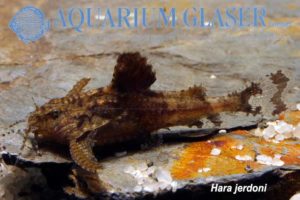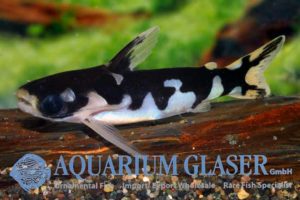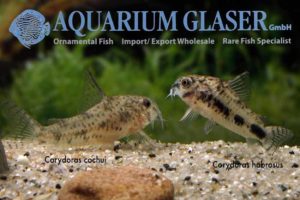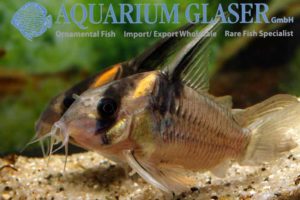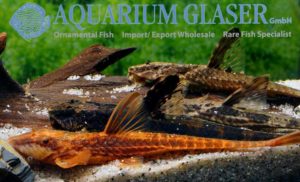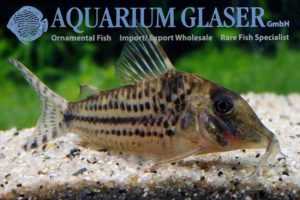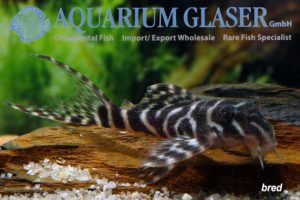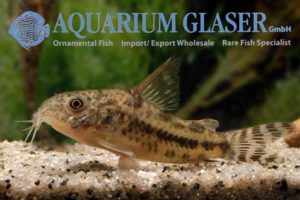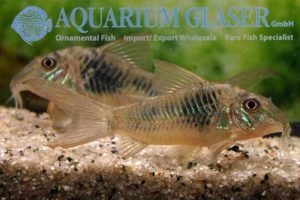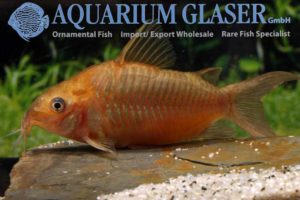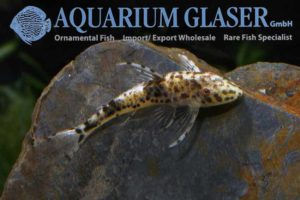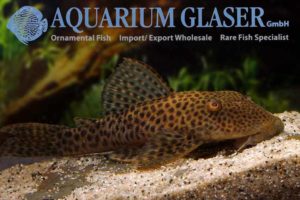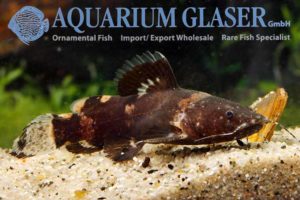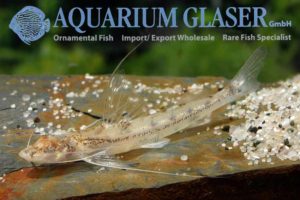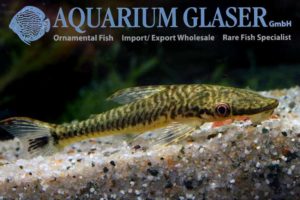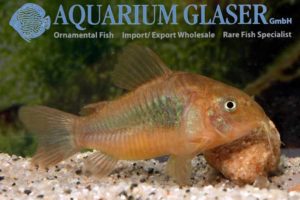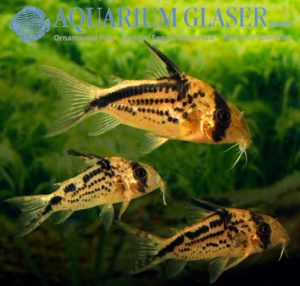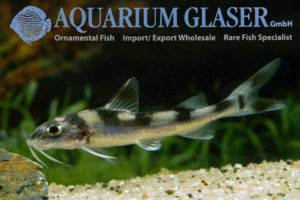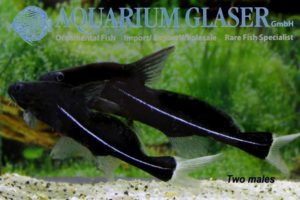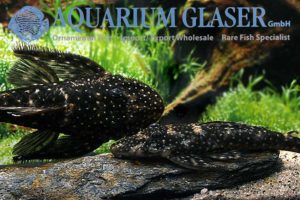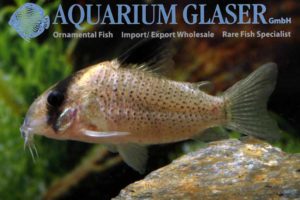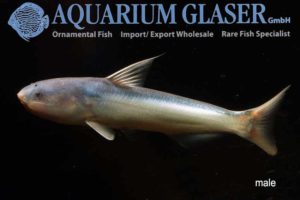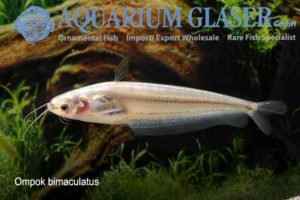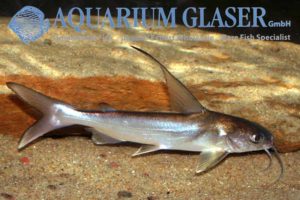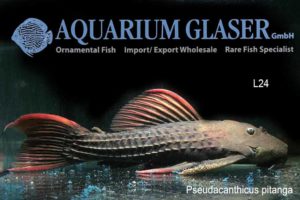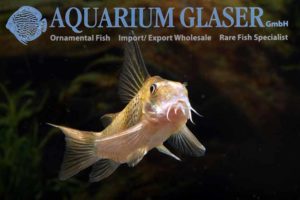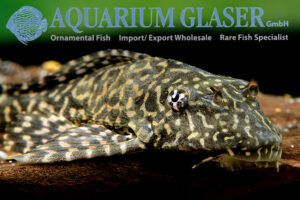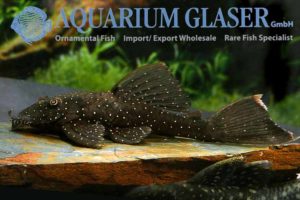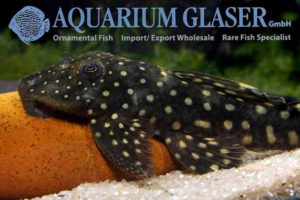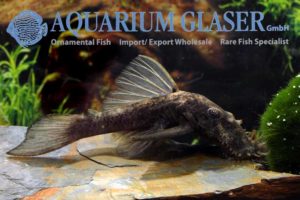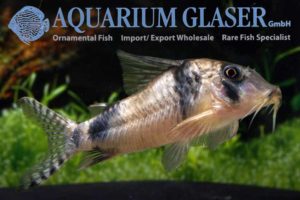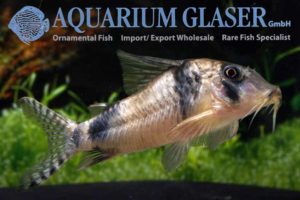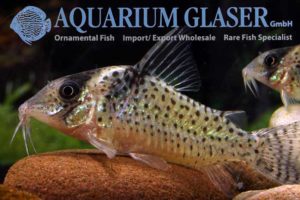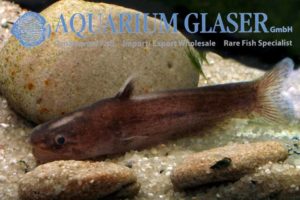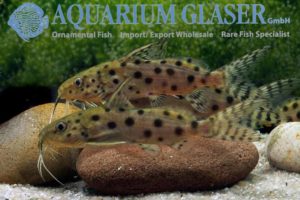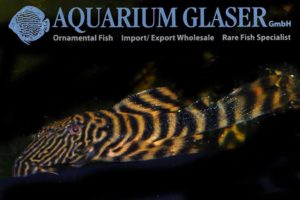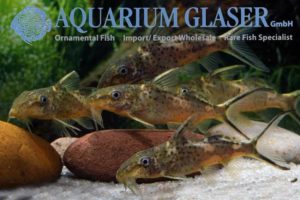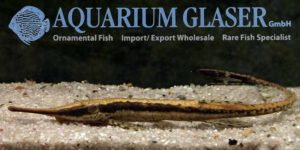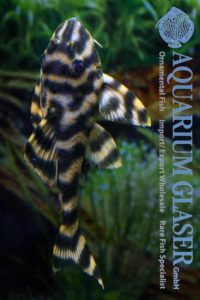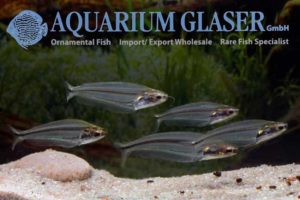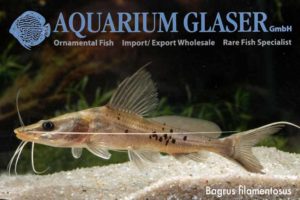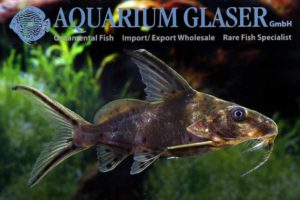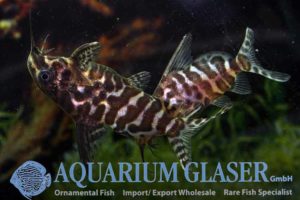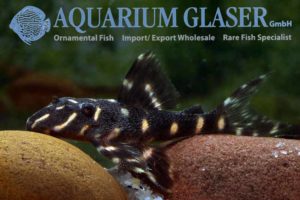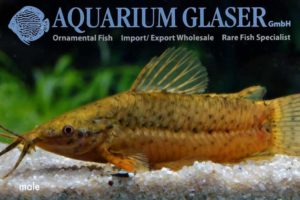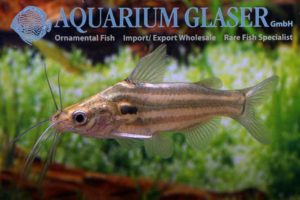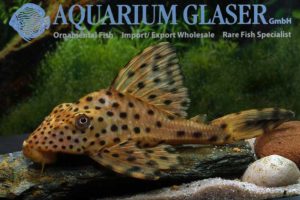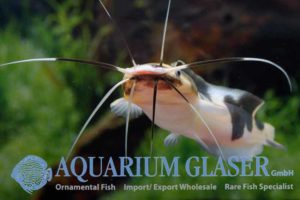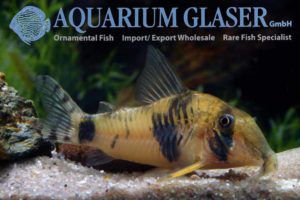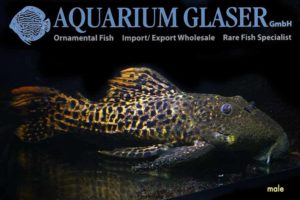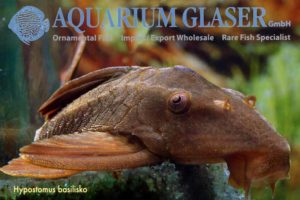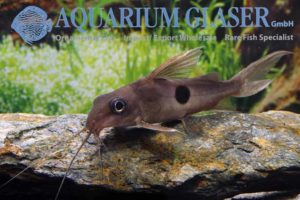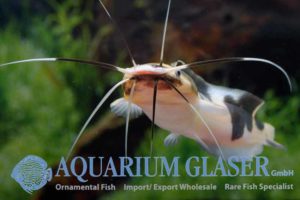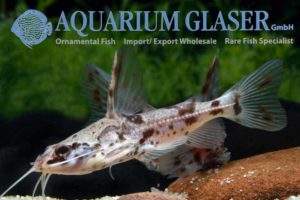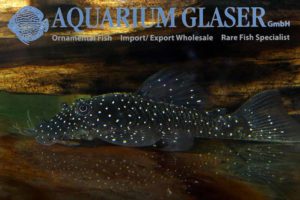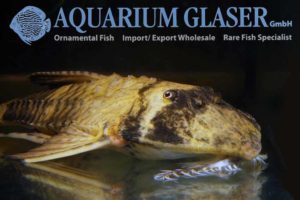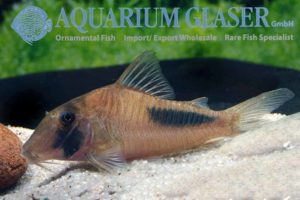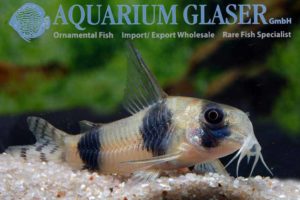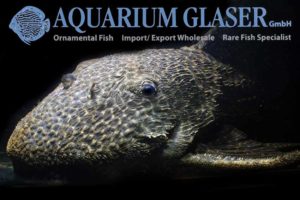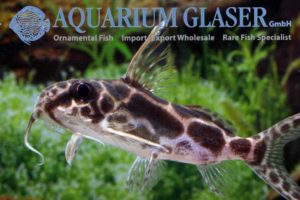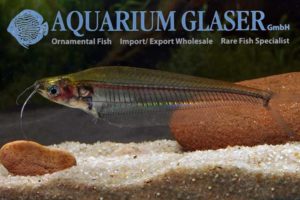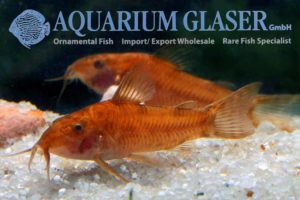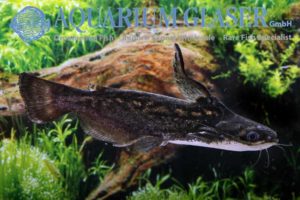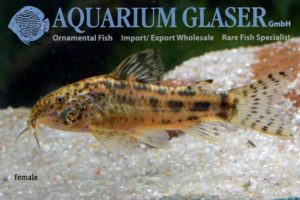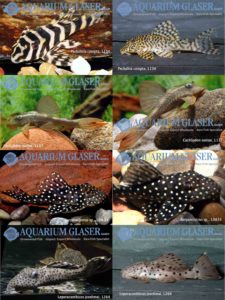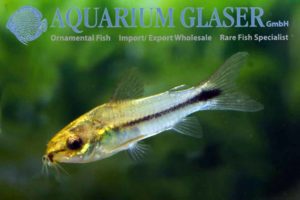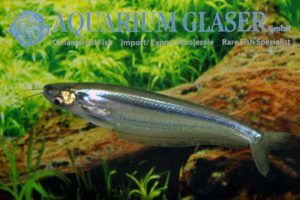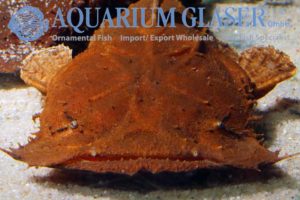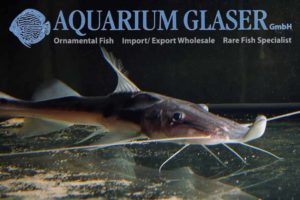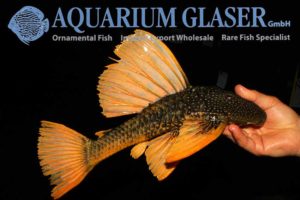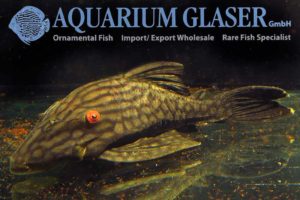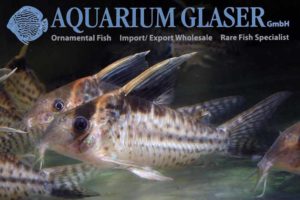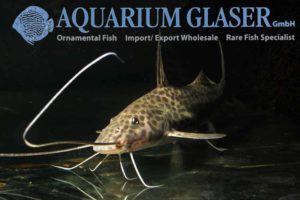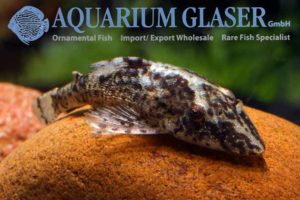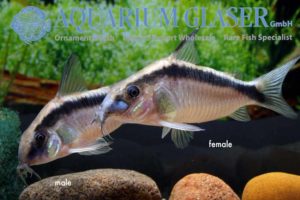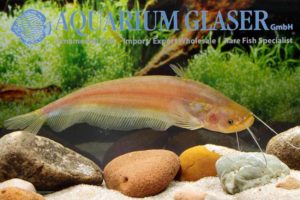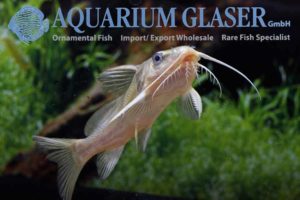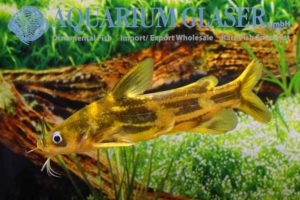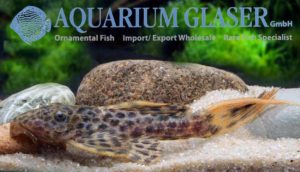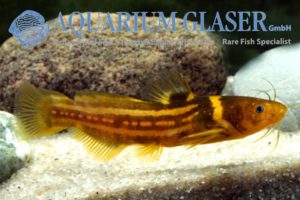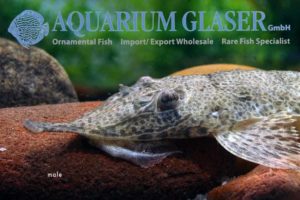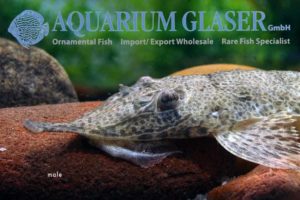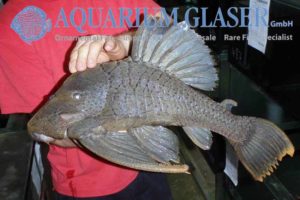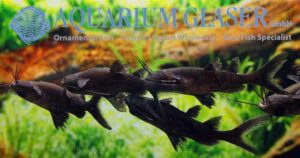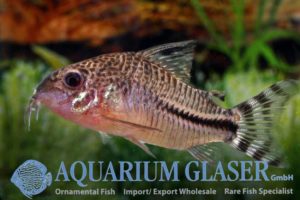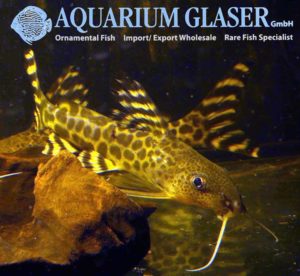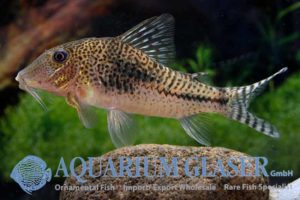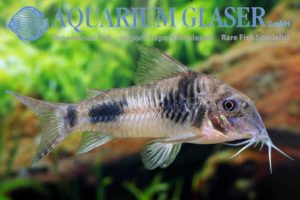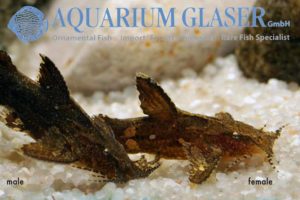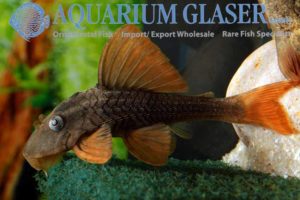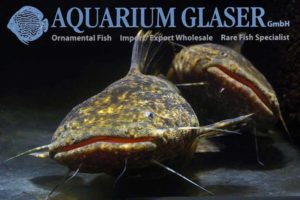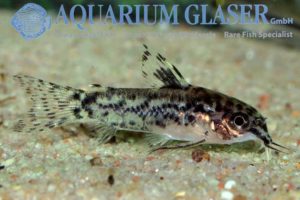Currently is the high season for the interesting moth cats (Hara). These catfish occur in India, Burma, and Thailand. The species are very difficult to tell apart, in many cases it is simply impossible in live animals. There are a few species that can be determined by a filament on the caudal fin, but most […]
10. Catfishes (750)
-
-
Tatia musaica (= Cenromochlus orca)
We were able to import again a small number of the most attractive of all driftwood-catfishes: Tatia musaica, the ninja-tatia. This beautiful fish attains a maximum length of about 5-6 cm. Like all the driftwood catfishes this species also has an internal fertilization. The male´s anal fin is modified for that purpose, similar as it […]
-
Corydoras cochui and C. habrosus
These dwarf species of Corydoras have been confused quite a long time. Both species attain a maximum length of about 3 cm and a very cute, nice and lively aquarium fish. If one has the opportunity to see live specimens of both species together it may be hard to understand how they may be confused; […]
-
Corydoras CW 45 Lessex
We can currently offer a very limited number of a new variety of the rare species CW 45. The fish was named “Lessex” by the exporter. We adopted that name, but we don´t know the meaning. CW 45 is a deep bodied species, similar to C. armatus. It differs from the latter by the bright […]
-
Rineloricaria lanceolata
Currently we obtain very nice Rineloricaria lanceolata from Paraguay. This species of whiptail catfish is very variable in respect of coloration. Almost all colours from deep dark brown (almost black) to a light clay-brown can be observed. It was back in the 1980ies that a brick-red sport of whiptail catfish appeared in the former GDR. […]
-
Corydoras vittatus
And here we have one more beautiful species of currently imported Corydoras. Corydoras vittatus – the specific name means “striped” – is one of the most variable species in respect of the individual pattern. The fish originates from Brazil. Formerly it was often regarded to be a subspecies of the also very variable species Corydoras […]
-
Hypancistrus sp. L66 King Tiger Pleco
The King Tiger Pleco originates from the Rio Xingu in Brazil. The species belongs to the most popular plecos in the hobby. This fish attains a length of about 15 cm. Currently we can offer very nice German bred ones (4-5 cm long), which have a pretty and strongly contrasting black-and-white-pattern. Like in all species […]
-
Corydoras diphyes and Otocinclus mimulus
Corydoras diphyes and Otocinclus mimulus are available irregularly in Germany and have been recently described by Axenrot and Kullander (2003). They originate from the tributary of the Rio Monday, a river flowing into the Rio Parana in Paraguay. This species was known, for quite a long time, as Corydoras flaveolus in the hobby; this species, […]
-
Unusual ornamental fish bred in Indonesia 2: Corydoras septentrionalis
Corydoras septentrionalis is rather rare in the trade. It occurs in Venezuela and Colombia. The species is very similar to Corydoras ellisae from Paraguay. It differs from C. ellisae mainly due to the much longer snout and the colourless fin (with a spotted pattern in C. ellisae). We were a bit surprised to obtain that […]
-
Corydoras pantanalensis C5
This species is one of the largest of its genus: C. pantanalensis can reach a total length of more than 8 cm! Now we finally were able once more to import these splendid pieces of gold in small numbers. Besides the impressive size Corydoras pantanalensis is also very interesting because the males develop during the […]
-
Parotocinclus cf. variola
For the first time ever we were able to import this interesting dwarf suckermouth catfish. It originates from a only recently discovered region, namely the waterfalls of Cachoeira do el Dorado in the far northern parts of Brazil, almost at the border to Venezuela. This area has not been explored ichthyologically yet. Of all the […]
-
Hypostomus sp. LDA10
The great rush for l-numbers is over, no doubt. But even at the highest level of the hype some of the species appeared only once or twice in the ornamental fish market. One of those guys is LDA, a species of Hypostomus with an extraordinary broad head. Obviously this species lives syntopically with the much […]
-
Batrochoglanis raninus Dwarf
Batrochoglanis raninus Dwarf The genus Batrochoglanis was formerly placed in Pseudopimelodus. Batrochoglanis can be best distinguished from Pseudopimelodus by the shape of the caudal fin. Pseudopimelodus has a deeply forked caudal fin, Batrochoglanis only a slightly indented one. Currently five species of Batrochoglanis are accepted. We obtain occasionally specimens of that genus from Colombia, which […]
-
Mastiglanis asopos
Catfishes in general often look quite odd. This is for sure true for this dwarf catfish, which was described only in 1994 in a new genus. The maximum length of this fish is about 6-7 cm without the caudal fin. The shape of the body is very elongate. The extremely long pectoral fin rays are […]
-
Hypoptopoma cf. psilogaster “sp. II”
The dwarf catfish of the genus Hypoptopoma are close relatives of the much better known Otocinclus species. Both genera have a similar habit and a similar way of life. Members of Hypoptopoma have a very typical position of the eyes. This gives them the advantage to be able to see what happens below them them […]
-
Corydoras aeneus Cuiabá
The Bronze Cory is the most popular and most widespread Corydoras in the hobby. This stands in a strong contrast to the scientific knowledge about the systematics of that species. From a systematist´s point of view the Bronze Cory is among the least understood species of the genus. Currently only one species is accepted, which […]
-
Corydoras loxozonus
This cory belongs to the most attractive members of the genus Corydoras and is also very easy to keep. One should only remember that C. loxozonus – it originates from the Rio Orinoco and its affluents – prefers higher temperatures. So the water temperture should not sink below 25°C for longer. Currently we can […]
-
Gagata cenia
The Assamese Clown Catfish is the perfect choice for all aquarists that love lively species. This catfish attains a maximum length of about 15 cm, but matures at a length of less than 7 cm. The fish is a real energy pack. It can be hardly ever found resting for a minute, it is always […]
-
Bagrichthys macracanthus
Currently we can offer a very seldom imported, unusual catfish from Southeast Asia (eastern Sumatra): Bagrichthys macracanthus. This catfish attains a maximum length of about 20 cm. In the wild, the species inhabits river portions with only very low current. Against conspecifics males are quite quarrelsome; kept by pair or in groups composed of one […]
-
Flyer-cats from Brazil!
Recently we received a shipment of flyer-cats (Pseudolithoxus), which have been collected in the surroundings of Sao Gabriel do Cacheiro at the Rio Negro. At the first glimpse the fish look very similar to P. anthrax (L235) from Venezuela. But they are distinguished from the latter by the much larger white spots and the white […]
-
A brandnew Corydoras – Corydoras sp. aff. potaroensis
Sometimes it’s hard to believe. If one reminds that currently 160 species of Corydoras are scientifically accepted, plus 159 C-numbers, plus 107 CW-numbers, it is more than likely that every newly imported Corydoras could be applied to at least one of these fish. But far from that! Last week we obtained Corydoras under the name […]
-
Cetopsis coecutiens
This species is legend. Cetopsis coecutiens becomes up to 40 cm long and is spread very far over South America – and feared! The animals are merciless hunters. Even when trapped in a fish cast they bite pieces out of their fellow captives. Even attacks on humans are reported. People living along the Amazon river […]
-
Ompok bimaculatus and O. pabda
Ompok are medium sized catfish that reach a length of 15-40 cm. They are close relatives of the only central European species of catfish, the Wels (Silurus glanis). Ompok look quite similar to the Wels. In southern and southeastern Asia, Ompok are favorite food fish, despite the fact that they are comparatively small. They are […]
-
Nemapteryx nenga
This beautiful “freshwater shark” reached us from India. Formerly the species was placed in the genus Arius. Like all these Arius-relatives Nemapteryx nenga is not a shark at all, but a catfish. N. nenga attains a length of about 30 cm and should be kept in large aquaria only. These “freshwater sharks” are animals that […]
-
L24 has been described: Pseudacanthicus pitanga
Another L-number has received a correct scientific description finally: L24. The beautiful orange finned cactus pleco from the Rio Tocantins is named now Pseudacanthicus pitanga. The specific name “pitanga” is from the Tupi-Guarini language and means “red” in allusion to the colour of the fins. The scientific paper also discusses the risks of using this […]
-
Corydoras armatus Venezuela
Corydoras armatus belongs to the species of Corydoras which are known by scientists very long already. It represents the sixths described species of the genus. The original descriprition appeared back in 1868. The type specimens originated from Peru (Rio Huallaga). It is quite astonishing that the species appeared comparatively late in the hobby – in […]
-
Glyptoperichthys joselimaianus: L1
L-numbers are for many people simply synonyms for Loricariids. But one should remember that they have been cooked up only in 1988! L-numbers were given for species that have not been determined scientifically yet. The very first L-number, L1 (or L001, although nobody would have dreamed of hundreds of L-numbers initially) has been applied on […]
-
Ancistrus sp. L181 Rio Negro
The many species of Ancistrus with small white dots are very difficult to tell apart. We recently obtained L181 from the Rio Negro in Brazil. The very same species has been given several L-numbers, eg L71 (from the Rio Tapajós) or L249 (from the Rio Trombetas and its affluent, the Rio Cuminá). Also extremely similar […]
-
Pseudancistrus sp. LDA 32/L259/L321 Rio Tapajós
Currently four syntopically occuring forms of Pseudancistrus are reported from the Rio Tapajós. They differ from each other by minor differences in respect of coloration and proportions. L321 is the comparatively flattest of them, has small dots and a reddish seam at the caudal fin. LDA32 and L259 are a bit deeper bodied and have […]
-
Ancistrus sp. Black Rio Negro (L88)
We received a good number of pure black Ancistrus from the Rio Negro. These have no clearly visible markings, except one: a deepblack spot on the basis of the dorsal fin. This somewhat unspectacular, but characteristic feature made finally the determation possible. Our fish belong to the species named “L88” or Anstrus sp. Black (the […]
-
Corydoras sp.
Another extremely rarely imported Corydoras species reached us from Peru. The unusual popular name of the scientifically undescribed species is due to the coloration, especially the dark triangle in the neck. This reminds one very much to the odd type of headdress worn by Gustaf Gründgens in his legendary production of Goethe´s Faust, where he […]
-
Corydoras sp.
The longsnouted and saddle-nosed Corydoras appear in the wild either solitary or in small schools. This is the reason why they are much more difficult to collect than the round-nosed Corydoras which most often live in very large swarms. This fact makes the longsnouted and saddle-nosed Corydoras much more expensive and also more desired by […]
-
Corydoras crimmeni
For the first time ever we can offer this beautiful Corydoras. It originates from the Rio Negro basin in Brazil. A bright green shine on the flanks of the body is very obvious, especially when the light falls from ahead on the fish. This species attains a maximum length of about 6.5 cm. For our […]
-
Denticetopsis seducta
For the first time ever we could import this dwarf whale catfish from Peru. The maximum length of this tiny species seems to be around 5-6 cm. In contrast to the better known blue whale catfish, Cetopsis coecutiens, which is an aggressive predatory species, all Denticetopsis are competely harmless insectivorous fishes. This species has been […]
-
Synodontis ocellifer
This is another catfish-beauty originating from Nigeria. Someone once said that this species of Synodontis can be characterized by three adjectives: peaceful, beautiful, and hardy. In fact S. ocellifer is one of the most peaceful species of Synodontis at all. The maximum length of S. ocellifer is about 20 cm. When they get older they […]
-
Panaqolus sp. Alto Nhamunda
Along with the spectacular Peckoltia sp. “Alto Nhamunda” (see http://www.aquariumglaser.de/en/news.php#1245) a specimen of Panaqolus reached us, which is very similar to the L-number L374. Very similar is also L403. Both L-numbers most probably represent the same species. One should not forget that a L-number is not given for new species, but for Loricariids exported from […]
-
Synodontis sorex
Two weeks ago we presented to you some species of catfish we imported from Nigeria. This wonderful shipment contained also some by-catches, which are species that were send erroneously along with the ordered specimens. One of these by-catches came with Synodontis clarias. It was the extremely rarely imported species Synodontis sorex. This “Scissortail-Squeaker” has a […]
-
Farlowella vittata
The needle suckers of the genus Farlowella are quite specious. To date 27 species are recognized as valid. As many species look very similar to each other the exact determination often proofs to be quite difficult. The 27th species has been described very recently from Colombia (it is the species Farlowella yarigui which has not […]
-
Peckoltia sp. Alto Nhamunda
We are glad to be able to present to you another jewel by the end of the week again. We could import last year already a new species of Peckoltia from the upper Nhamunda River in Brazil, which is also famous for its pretty discus. This first importation contained only fully grown specimens (see http://www.aquariumglaser.de/en/news/Peckoltia_sp_Alto_Nhamunda_en/). […]
-
Parailia pellucida
The species in our small series on catfishes from Nigeria is – in contrast to the species described so far – always available and it fits perfectly in any community tank: the African Glass Catfish, Parailia pellucida. The maximum length is given with 15 cm in literature; however, we see only very rarely specimens larger […]
-
Bagrus filamentosus
The African genus Bagrus contains large, predatory catfish. The maximum size of the different species is between 30 cm and more than one meter! Sadly the determination of the species is rather difficult, because most of the 11 species that are regarded as valid currently have been described before WW2. A modern revision does not […]
-
Synodontis clarias
This week we want to focus on unusual species of catfish from Nigeria. Today: Synodontis clarias. This is the first species of Synodontis that became known by scientists. The original scientific description dates back to 1758 and was done by Linnaeus. Nevertheless the species is exported only very occasionally for aquaristic purposes. The fish attains […]
-
Synodontis batensoda
There does exist a good number of species of Synodontis that tend to swim upside down. The best known species is without any doubt the upside down cat, Synodontis nigriventris from the Congo. Now we were able to import the very rarely offered Synodontis batensoda from Nigeria, which shows a similar behaviour. It seems to […]
-
L204 Panaqolus albivermis
One of the most beautiful L-numbers at all has obtained an official, valid name in 2013: Panaqolus albivermis. The species originates from Peru. We currently were able to import again a good number of wonderful young specimens of this small species of catfish (maximum length around 10 cm). Among them are also 5 spotted individuals. […]
-
Lepthoplosternum pectorale – Dwarf Hoplosternum
The Hoplosternum relationship belongs to the plated catfish and and is thus closely related to Corydoras & Co. Like these, they make good and interesting aquarium fishes. Sadly most species become quite large. So, the species of the genus Lepthoplosternum are the best choose for smaller tanks. The maximum size of the members of that […]
-
Mystus tengara (M. carcio)
We received the smallest of the striped catfish species from India, which were all called formerly “Mystus vittatus”. The small species also had to face a real mess regarding the correct naming. For a long time the small species was called M. tengara, currently most scientists believe that the correct name has to be M. […]
-
L167 arrived!
Finally we were able to import again one of the most attractive species of Cochliodon: L167. The species belongs to the typical representatives of the genus, which feed mainly on soft wood. This can be recognized by the very few teeth, which have a specialized shape with a broad, mussel-shaped cusp. L167 originates from the […]
-
Clarias gariepinus marbled
Sometimes it is almost impossible to distinguish between a food fish and an ornamental fish. The marbled Clarias is, however, bred in Southeast Asia as a food fish for human consumption. It grows extremely fast, is very hardy and can survive on the market without water for many hours, because it has an accessory breathing […]
-
Corydoras sp. Tukano Longnose
There are still species of Corydoras that are imported so rarely and in so low numbers that the fish stay unfulfilled dreams of most enthusiasts. One of the most attractive species of that group is for sure the “Tukanao Longnose”. Of course these animals are not rare in the wild in the sense that there […]
-
L273 Pseudacanthicus sp. Titanic XL
The Titanic was never traded in large numbers and is one of L-numbers in great demand. We received now three large specimens from Brazil, which seem to be fully grown. They are 25-30 cm long. One of them is for sure a male. It can be easily identified by the strong spines and the long […]
-
Cochliodon sp.
Among the most popular fishes from Paraguay is the Violet Red Bruno. Finally the species has attained a scientific name: Hypostomus basilisko. The distribution of the fish is the Rio Paraguay, both in Brazil and Paraguay. Here it occurs along with two quite similar species of the Cochliodon-group of Hypostomus, namely Hypostomus cochliodon and Hypostomus […]
-
Synodontis notatus
We were able to import a pretty species of squeaker from the Congo: Synodotis notatus. The species attains a maximum length of about 25 cm and is worth mentioning for at least two reasons: first, the number of spots on the flanks varies a lot individually. Most specimens have only one spot, but there are […]
-
Clarias batrachus marbled
Sometimes it is almost impossible to distinguish between a food fish and an ornamental fish. The marbled Clarias is, however, bred in Southeast Asia as a food fish for human consumption. It grows extremely fast, is very hardy and can survive on the market without water for many hours, because it has an accessory breathing […]
-
Amblydoras nauticus
Catfishes have no scales. But many species have bony plates that cover and protect the body. In the family Doradidae these plates are sometimes additionally armored by spines. One of the most common species of Doradidae in Amazonia is the marbled talking catfish, Amblydoras nauticus. The species is not very popular by the natives, because […]
-
L107 / L184 Brillant-Ancistrus
Among the most beautiful species of Ancistrus is this one. It originates from the middle Rio Negro area in Brazil and is not yet determined scientifically. Instead even two L-numbers have been given to it, namely L107 and L184. The Brilliant Ancistrus is a very peaceful species. The number and size of the white spots […]
-
Paraloricaria vetula
The genus Paraloricaria contains three species that are distributed in southern South America. The fish are virtually unknown in the hobby. This is for sure at least in part due to the enormous size the fish can reach. At least P. commersonoides and P. vetula become larger than 50 cm. For the first time ever […]
-
Corydoras amapaensis
Finally we were able to import again a small number of the extremely rarely offered long snouted Corydoras amapaensis. The species is highly variable in respect of coloration. The sexes can be distinguished best by the shape of the spines of the pectoral fins, which are thickened and hairy in males. For our customers: the […]
-
Corydoras tukano
Hard to believe but true: it took five long years until we were able now to import once more Corydoras tukano. Now this pretty fish is finally available again. We obtained very stable, beautiful animals. For more information and how to distinguish C. tukano from its close relative C. reynoldsi, please see http://www.aquariumglaser.de/en/fish-archive/corydoras-en/_en-5/ For our […]
-
L234 Megalancistrus sp. Rio Urguayo
We were able to import two pretty gobbets from Paraguay, or, to be more detailed, from the Rio Urguayo. The two Megalancistrus are currently 40-50 cm long and show clearly why they have deserved their generic name: Megalancistrus means “gigantic Ancistrus”. Scientifically speaking, our fish most probably belong to the species M. parananus. For our […]
-
Synodontis robertsi
The squeakers (Synodontis) are a very species-rich genus. More than 130 species are known, all of them originate from Africa. In the countries of their origin most species are used for food. In the aquarium hobby most species are unknown with a few exceptions. Among the most pretty, smallest and rarest species of Synodontis is […]
-
Kryptopterus minor
The “Ghost catfish” has been kept for more than 80 years under a wrong name in our tanks. Initially it was determined as Kryptopterus bicirrhis, afterwards as K. minor. However, both determinations proofed to be wrong, the species was in fact new to science and still undescribed! Now it has a final name, ie Kryptopterus […]
-
Aspidoras sp. C125 Red
Yesterday we introduced to you the pretty Aspidoras taurus (see http://www.aquariumglaser.de/en/news/Aspidoras_taurus_en/). We received from the very same breeder for the first time the very nice albinotic red variety of Aspidoras sp. C125. The wild coloured variety looks quite similar to A. taurus, but the fish stays a bit smaller (4-4,5 cm). According to our breeder […]
-
Trachelyopterus fisheri
Currently we can offer a very odd species of catfish, namely Trachelyopterus fisheri. Initially this species of driftwood catfish orginates from Colombia where it is found in the system of the Rio Sucio. From that area only very occasionally importations appear. So we are quite happy that we have an adult wild collected male of […]
-
Aspidoras taurus
This pretty species of catfish is found only very occasionally in the trade. The species is not allowed to be exported from Brazil currently, so exclusively bred specimens are traded. We just received a small number of the attractive species from one of our breeders. Aspidoras taurus reaches a maximum length of about 5-6 cm. […]
-
L-numbers: the season starts for species from the Rio Tapajós!
-
Corydoras pygmaeus
The Dwarf corydoras (Corydoras pygmaeus) belongs without any doubts to the most attractive and interesting aquarium fish for small tanks. This dwarf becomes only 2-3 cm long and is a somewhat untypical member of its genus, for most species of Corydoras are bottom dwellers; C. pygmaeus prefers to swim in the open water column. Interestingly […]
-
Kryptopterus geminus
The glass catfishes of the genus Kryptopterus are close relatives of the Wels catfish (Silurus glanis). However, in contrast to this giant among the freshwater fishes (Wels catfish can attain a length of up to 2 meteres), the glass catfishes stay small. The largest species known so far (K. cheveyi from the Mekong basin) becomes […]
-
Chaca bankanensis
The frogmouth catfishes of the genus Chaca are very unusual fish. Only four species are known. The look quite similar to each other and form a catfish family on their own, the Chacidae. Chaca lie on the bottom without any move for most of the day. They wait for shrimps or small fish that take […]
-
Platystomatichthys sturio
Finally we are able again to offer one of the most bizarre species of predatory catfish of Amazonia: Platystomatichthys sturio. Anyone who sees the fish for the first time will think that the animal is distorted; however, the upturned snout-tip is rather species-specific. Nevertheless the grade of this upturn differs individually and depends also a […]
-
Hypostomus luteus
Yesterday the most beautiful of all plecos, Hypostomus luteus from Paraguay, arrived. Only fully grown specimens display the fantastic, reddish-yellow coloration, whereas young fish are black with light spots. All specimens are 35-40 cm long. For our customers: the animals have code 262639 and 262649 on our stocklist. Please note that we exclusively supply the […]
-
L330 Panaque sp. Spotted 14-18 cm
We have some specimens of this gorgeous, wood-eating pleco in stock. L330 originates from Colombia. Fully grown specimens get a spotted pattern all over the body. Younger specimens can look quite similar to L190 or Panaque nigrolineatus, because they usually show a striped pattern. The yellow tips of the caudal fin are a good hint […]
-
Corydoras robustus
This cory belongs to the largest and most attractive species of Corydoras at all. They can reach a total length of 9-10 cm. Both sexes develop long, filamentous dorsal fins when fully grown. The males can be best recognized by the much longer ventral fins. For our customers: the fish have code 244106 on our […]
-
Aguarunichthys torosus
We could import a very special fish for the hobbyists specialized in predatory catfish from Peru: Aguarunichthys torosus. This species has been discovered only in 1986. Isn´t it fascinating that nature has the same solution for totally different species over and under the water? The spotted pattern of A. torosus is very similar to the […]
-
Parotocinclus longirostris
These dwarf sucker cats reaches us from Brazil. They belong to the smallest species of sucker cat at all. Even fully grown they hardly extent 2.5 cm in length. The determination on species level is not absolutely confirmed, for obviously a complex of very similar species exists. However, in any case the fish are tiny […]
-
Corydoras sp Super Arcuatus
Finally we received again this gorgeous, rare species of Corydoras from the Rio Purus in Brazil. The fish become almost double size compared with the “common” Corydoras arcuatus. In any other respect both species can be handled the same: they are hardy and beautiful fish! For our customers: the animals have code 221855 on our […]
-
Ompok cf. fumidus
We don´t always get what we want. Initially we ordered the Malayan Giant Catfish Wallago leerii for one of our customers. But we received a species of Ompok from our Singapore supplier instead. However, this error is understandable. Even professional scientists have in the past confused both genera quite often and described a number of […]
-
Synodontis bastiani
The squeakers (Synodontis) are a species-rich genus of catfish from Africa. Currently 131 accepted species are known. The maximum size of these fish lies between 8 cm and 60 cm. Most species attain a maximum length of 15-20 cm in the aquarium. In their home-countries these fish are very common and heavily used as food […]
-
Tachysurus fulvidraco
We were able to import a second, beautiful Chinese catfish after Pseudobagrus trilineatus (see http://www.aquariumglaser.de/en/pseudobagrus-trilineatus_de_1581.html).Trachysurus fulividraco becomes about 12-15 cm long and is a perfect catfish for larger, unheated aquaria.The species is also often placed in the genus Pelteobagrus, but the international trade name is much more interesting: Chinese highway catfish! However, the scientific name […]
-
L114 Pseudacanthicus sp., small
-
Pseudobagrus trilineatus
This very interesting catfish originates from China. We received our first importation of the species now. The fish become about 7.5 cm long and live endemically (= they occur nowhere else) in the Dong Jiang influence in the Chinese province of Guangdong. There is no universal agreement among ichthyologist in which genus this fish should […]
-
Hemiodontichthys acipenserinus
This species has been named “Pinocchio cat” in the trade due to its funny looking nose. The species represents the smallest of all mouthbrooding whiptail cats – it usually grows only to 10 cm total length in aquaria – and is thus very well suited for keeping. We currently were able to import these beautiful […]
-
Hemiodontichthys acipenserinus
These strange whiptail catfish, in nature living in a sandy habitat, are regularly imported, although in low numbers. This species requires a sandy substrate, in which they can hide themselves. Because this is a shy fish absolute care needs be taken in the choice of tank mates. The reproduction of this species is not very […]
-
We can “big”, too…L191
Ornamental fish are not necessarily small. Last week we received this juggernaut, a Panaque sp. “L191”. The animal has taken the transit from Colombia in our fishhouse in stride and has settled down perfectly.
-
Mystus leucophasis (formerly: Heterobagrus leucophasis)
The Upside-Down-Cat from the Congo (Synodontis nigriventris, see http://www.aquariumglaser.de/en/news/Synodontis_nigriventris_finally_available_again__en/) is known by any aquarists child. But even experienced aquarists often don´t know that in Asia (in Burma) also occurs an upside down swimming species: Mystus leucophasis which can attain a maximum length of about 30 cm, but is commonly found 15-20 cm long. The schooling […]
-
Corydoras sp. Manu5 (CW062)
Currently we received a number of still undescribed species of Corydoras from the Madre de Dios region in Peru, among them the very pretty Corydoras sp. Manu5. The Rio Manú is the larger of the two headstreams of the Rio Madre de Dios. Corydoras sp. Manu5 has the CW-number 62. For our customers: the fish […]
-
Synodontis pardalis
We received with the current Cameroon importation this beautiful squeaker, which can attain a maximum length of about 20 cm. The species is known only from the river Dja and its affluent Libi. This is the reason why the fish is considered an endangered species, for the Dja is heavily destroyed and polluted due to […]
-
Corydoras sp. Eder
We obtained from the Madre de Dios region in Peru this extremely rare and beautiful long snouted Corydoras und the name of Corydoras sp. Eder I and II. From a zoological point of view both represent the same species, which is very variable in respect of coloration. In the hobby there are several synonyms for […]
-
Corydoras ellisae
A beautiful, but sadly only rarely available cory from Paraguay. This species is the long-snouted counterpart of the most widespread cory in the hobby, the Peppered Corydoras. Text & photos: Frank Schäfer
-
Pseudolaguvia muricata
Catfishes from Asia are sadly not “en vogue” currently. On the other hand, many new, attractive species have been discovered recently, which are perfect aquarium inhabitants. The first species of the genus Pseudolaguvia was discovered back in 1927, but only recently it was found that this genus represents a species-rich one. Pseudolaguvia are dwarf catfish […]
-
L137 Hypostomus soniae / Cochliodon soniae
The pretty, blue-eyed L137 from the Rio Tapajós is only rarely offered. It is a medium-sized species of Hypostomus that can reach a maximum length of about 20 cm. The colour of the fish is quite variable. Specimens exist that have rather brown fins, others have spotted fins and again others have bright orange-red fins. […]
-
Cephalosilurus apurensis
We have a real delicacy for fans of predatory catfish in small numbers in stock: Cephalosilurus apurensis. This species becomes around 30 cm long. The fish are very hoggish and real personalities! For our customers: the fish have code 214633 on our stocklist. Please note that we exclusively supply the wholesale trade. Text: Frank Schäfer, […]
-
Aspidoras pauciradiatus
Finally the season for this charming dwarf has started. The species originates from the Rio Negro basin and attains a maximum length of about 3 cm. It is an ideal tankmate for tetras, dwarf cichlids etc. For our customers: the fish have code 208704 on our stocklist. Please note that we exclusively supply the wholesale […]
Leporacanthicus from the Rio Tapajós: L263 and L264




We
received from Brazil two species of pretty carnivorous loricariids.
Both originate from the Rio Tapajós, where they occur even syntopically.
L264 has been described scientifically under the name of
Leporacanthicus joselimai, whereas L263 still waits for a scientist to
take a closer look on it.




It is very unusual that two closely related species live in the wild together. Usually one species will dominate the other. But in this case it obviously works. Both L-numbers for sure represent species on their own, as both have been bred already successfully in aquaria.
Both species attain a maximum length of about 15-20 cm.
For our customers: the fish have code 26480-L 263-3 (L263) und 26480-L 264-3 (L264) on our stocklist. Please note that we exclusively supply the wholesale trade.
Text & photos: Frank Schäfer
Panaque Blue-Eye

We
were able to import two large males of this top rarity. There is still
an ongoing debate among specialists whether Panaque suttonorum (= P.
suttoni) and P. cochliodon do represent the same species or not.
However, in the most recent scientific revision, P. suttonorum is
considered to be valid.

For
our customers: the animals have code 275007 on our stocklist. Please
note that we exclusively supply the wholesale trade. Only two specimens
available!
Text & photos: Frank Schäfer
Finally available again: L135!


The
L-catfish L135 belongs to the most attractive L-numbers. Most
specialists currently believe that it represents a variety of the
species Peckoltia braueri. This species has been given also two other
L-numbers, eg 121 and 305. L135 from the central Rio Negro basin is the
most colourful of them. This catfish attains a maximum length of 12-15
cm and has been bred in aquaria already. It is only very rarely
available as wild collected stock, so we are quite glad about our
successful importation!


For
our customers: the fish have code 26480-L 135-1 on our stocklist.
Please note that we exclusively supply the wholesale trade.

Text & photos: Frank Schäfer
Extraordinary rare thorny catfish from Peru
The
Thorny Catfishes (Doradiae) are a small family of exclusively South
American catfish. Currently 41 genera containing 127 species are known,
but continuously new species become discovered. The largest species
attain a maximum length of more than 100 cm. The world record for
Opsodoras niger is 120 cm and a weight of 20 kg. The smallest species –
Physopyxis lyra – becomes only 3.5 cm long. Most species attain a
maximum length between 10 and 20 cm.
We currently have some very rare species from Peru in our stock which we want to introduce to you here.
Megalodoras uranoscopus
is one of the large species. It can become about 50 cm long. Juveniles are pretty fish and now and then imported (see http://www.aquariumglaser.de/en/news/Megalodoras_uranoscopus_irwini__en/).
Currently we have three mighty big ones of 25-30 cm length in stock. A
well known synonym of the species is Megalodoras irwini. Codenumber on
our stocklist: 267526



Nemadoras elongatus
becomes only 12 cm
long. The peaceful animals love to swim in schools. Males seem to stay
about one third smaller than the females. Sadly almost nothing is knowns
regarding the breeding biology of doradids which is also true for this
species. Code: 272482







Hemidoras morrisi
resembles Nemadoras
elongatus in respect of coloration, but is much more elongate, has a
stronger sculpure of the bony ridges and the dorsal spine is heavily
serrated on both sides, while it has a serration only backwards in N.
elongatus. H. morrisi becomes about 15 cm long and is rather night
active. For us this is the first importation of the species. Code:
257803





Pterodoras granulosus
is a large species again, which can become around 70 cm
long. However, we obtained juveniles of 6-7 cm. This species is as
peaceful as any species of thorny catfish, but one should keep in mind
that the fish has a large mouth and smaller fish will vanish there of
course… Code: 286582


Please note that we exclusively supply the wholesale trade.
Text & photos: Frank Schäfer
Finally available again after many years: L354

We
are glad that we were able to import once more the pretty L354 from the
Rio Iriri. The species has been described scientifically under the name
of Spectracanthicus zuanoni in early 2014. The scientists declare them
conspecific with L20 from the Rio Xingu (the Rio Iriri is an affluent of
the Rio Xingu). However, L20 has much smaller spots. In the very same
scientific paper the genus Oligancistrus has been declared as a synonym
of Spectracanthicus.


Anyway:
we are very glad to see the beautiful animal again in our fishhouse!
Spectracanthicus zuanoni attains a maximum length of about 15 cm.
For
our customers: the fish have code 26480-L 354-2 (6-8 cm) and
26480-L354-3 (8-10 cm) on our stocklist. Please note that we exclusively
supply the wholesale trade. Available in limited numbers only!
Text & photos: Frank Schäfer
New, rare Corys
We received recently a larger
shipment of beautiful, fully grown Corydoras burgessi. The import
contained some bycatches. A closer look on them showed that they
represent species that have not been reported yet from the area of the
upper Rio Negro (where C. burgessi is collected).
CW 89



Initially we
thought that these fish would represent C 39, a heavily build fish that
reminds in all other respects in C. imitator. But the black band on the
back of C 39 runs exclusively above the middle of the body, while in our
specimens this band runs through the middle of the body to the lower
border of the tail as it is well known from C. melini. This feature fits
to CW 89 that is, however, reported so far only from Colombia (Rio
Vaupes).
C 84


What has been
found in CW 89 is also true for C 84. Our shipment contained only four
specimens of this charming, rund-nosed species. C 84 is reported until
now also only from the Brazilian/Colombian border (Rio Tiquié). The
coloration of our fish differs hardly. Obviously CW 89 and C 84
represent a species pair of a longsnouted and a roundsnouted species of
Corydoras.
C 140?


We are not really
sure about the identity of this beautiful “longnose-burgessi” that is
represented by three specimens only so far. The body shape and pattern
fit very well to C 140, but our fish have a bright shining orange spot
(as in C. burgessi). This is not observable in the photos of C 140
published so far. The “longnose-burgessi” is a very striking species.
Possibly we will be able to import a larger number of them in the near
future. We are sure that this beautiful fish is an enrichment for the
aquarium hobby.
For our customers: the Corydoras sp. CW 89 has
code 216304 and the stocklist-name “melini longnose” on our stocklist.
Please note that we exclusively supply the wholesale trade.
Text & photos: Frank Schäfer
Ancistrus White Seam

Dear
customers, the scientific names in Ancistrus are sadly a total mess.
First of all: the genus Ancistrus contains a large number of species.
Currently 66 species are accepted, scientifically described species in
Ancistrus. However, in former days a great number of species has been
described under the generic name of Ancistrus, which currently are
placed in totally different genera – examples are Lithoxus,
Pterygoblichthys, Hemiancistrus, Dekeyseria etc.. So one must be aware
that reviewing these genera will probably recover other, additional
species and will make changes of names necessary.

The
“Common Bushmouth” has been established in the 1950ies in our tanks. At
that time nobody even guessed how many species exist. This is the
reason why that fish was determined under the name of Ancistrus
dolichopterus. At that time it was usual practice to cross in
established aquarium populations wild collected specimens for
“refreshing of blood”. So we can be almost absolutely sure that our
“Common bushmouth” is a cross, a multiple hybrid. At least no species is
known from wild populations that has exactly the features that our
“Common Bushmouth” has. It is comparably easy to cross different species
of Ancistrus, as it in between platys and swordtails. This is no
criterion for species discrimination.

Nowadays
are not only the 66 scientifically described species known, but also
another 90 species – some with, some without a L- oder LDA-number (see
Mergus Atlas on catfishes, vol.2). All of them are occasionally imported
or bred. We are far from understanding the systematics of all these
fish, but one thing can be said for sure: Ancistrus dolichopterus is one
of the so called White Seam Ancistrus and has been given the L-number
183. So please keep in mind: L183 = Ancistrus dolichoperus.

The
“Common Bushmouth” is a cross and so it cannot bear a scientific
species name according to the international rules of scientific
nomenclature. From a scientific point of view it must be named by the
generic name only, eg Ancistrus.
There is more than one species
of Ancistrus with a white seam in the dorsal and the caudal fins. A.
dolichopterus can usually easily recognized by the fact that it has 9
soft rays in the dorsal fin (all other similar Ancistrus have 7-8). Only
very occasionally individuals of A. dolichopterus with less than 9 soft
rays in the dorsal fin occur. The coloration is no good determination
feature, for juveniles look different than adults and Ancistrus can
change their colours also mood-dependent quite quick.

Before
it was found that L183 is Ancistrus dolichopterus, L183/White Seam
Ancistrus was wrongly determined as Ancistrus hoplogenys. However, today
we know that Ancistrus hoplogenys is identical with L59, which has
orange seams on the dorsal fin. There is another species of Ancistrus
which is repeatedly confused with Ancistrus dolichopterus, L183/White
Seam Ancistrus. This species obtained several L-numbers: L71, L181 and
L249. However, all these L-numbers represent the same species. It was
given the common name “false hoplogenys”, because only the small
juveniles have the pretty white seams, in contrast to the “true
hoplogenys” (which is Ancistrus dolichopterus, L183/White Seam
Ancistrus) which has these white seams the whole life through. In “L71,
L181 and L249” these white seams disappear in elder fish. Sadly both
forms are not distinguished in Brazil. So even we never know what we
will get when we order small White Seam Ancistrus from Brazil.

Sadly
this mess in names still persists. Please note that on our stocklist
due to technical reasons no solution that satisfies all needs is
possible. So the “Common bushmouth” is still called “Ancistrus
dolichopterus” and has code 20420. We call all undeterminable wild
collected Ancistrus that look similar to the “Common bushmouth”
“Ancistrus dolichopterus wild”, code 20411. The real A. dolichopterus or
“L183/real hoplogenys/white seam” has code 20440 and the name A.
hoplogenys. Juveniles, that could be both L183 and L71, L181 and L249 we
call Ancistrus sp. White Seam, code 20480.
Despite the fact that
we are always trying to use correct names, this seems to be impossible
in some special cases, like this one. If you are in doubt which species
is meant on the stocklist, please don´t hesitate to ask our employees.
Thank you!
Text: Frank Schäfer, photos: Frank Schäfer, Dieter Bork, Erwin Schraml
Gorgeous LDA7 in stock


We
have only very rarely the opportunity to be able to offer that
wonderful species of Pseudacanthicus. Currently we have even a number of
specimens of LDA7 in an ideal size in stock.


For
our customers: the fish have code 26480-LDA007-7 on our stocklist.
Please note that we exclusively supply the wholesale trade.

Text & photos: Frank Schäfer
- « Previous Page
- 1
- …
- 3
- 4
- 5
- 6
- 7
- 8
- Next Page »





